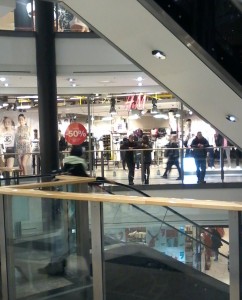Science Seen Physicist and Time One author Colin Gillespie helps you understand your world.
One From the Road
Wanderlust has got us traveling again. We are in Europe, taking trains and walking in cold city streets. What is hot in Europe now? (Okay, this is not rocket science. It’s not obvious that there is any science in it, though there is.)
Hot? How about those Poles? We’re checking out their second city, Krakow, less then half the size of Warsaw. Grand cathedrals. Hot economy. Cool kids. Most of them are working on their educations―the Organization for Economic Cooperation and Development says 53% of today’s young Poles will finish university, third highest score among 29 OECD countries. In Krakow many hang out in a cool mall too. Tied into a new international railway station, Galeria Krakowska has acres of hot labels from around the world. It sports cool prices, like (US) 75 cents for a salad or a sandwich and a coffee while you while away your Wi-Fi day. Seeing this scene should shatter your old images of Poland. Of its economy the World Bank says:
on their educations―the Organization for Economic Cooperation and Development says 53% of today’s young Poles will finish university, third highest score among 29 OECD countries. In Krakow many hang out in a cool mall too. Tied into a new international railway station, Galeria Krakowska has acres of hot labels from around the world. It sports cool prices, like (US) 75 cents for a salad or a sandwich and a coffee while you while away your Wi-Fi day. Seeing this scene should shatter your old images of Poland. Of its economy the World Bank says:
It has been nearly a decade since Poland joined the European Union (EU), during which time the country has implemented a series of economic and social reforms that have transformed Poland’s economy and allowed the country to converge with other EU member states at an astounding pace.
Unlike much of the EU, Poland is not tied to the euro’s woes. Unlike the EU’s, its economy, already hot, grew right through the recent troubled times. In ten years its domestic product more than tripled (while that of neighbouring Ukraine increased by barely one-third). You can feel its economic vigour on the streets and see it in the malls. What a striking difference from Lviv, a similar-sized city just across the border in Ukraine where the officially-dismissed Soviet-era state of mind seems to still linger in the air.
Not that Poland is a perfect world. Examples of its problems are easy to find. Unemployment is still high. Too many young people need to leave in search of work. Especially outside the cities many people are still poor. Bringing old infrastructure up to standard is taking time; often faltering on faulty rails the Inter City ‘express’ from Katowice took two hours to travel 50 miles.
So what about the science? Poland has a long and honourable science history. Think Marie Curie, first female winner of a Nobel Prize, to this day the only woman to win two (and her family won five). But, as it was back then, it seems Poland has a stuffy academic scene. Inicjatywa Otwieracz is a grassroots group of University of Warsaw students looking to shake up that scene. It says:
Renowned Polish universities are positioned fourth hundred in world university rankings while a conservative approach to research and teaching still prevails in academic circles. Older generations of scientists dominate the young [and] digital technology is not widely used either in research or teaching practices….
The OECD says they are right; it speaks of ‘a weak academic system’ and of weak links of industry to science as ‘a legacy of the state planned economy.’ So the good news is there’s opportunity for more improvements and some of the new generation are looking to try out new things. But strangely the official strategy is based on more planned economic actions. Will more of the same lead to something different this time? Maybe; but I’d give better odds on the new generation.
Back to the streets of Krakow. This place is great for laid-back travel. Lunch on a giant baked potato, sour cream, chives and roasted onions at a street kiosk for $2; dine on baked fish filets and heaped plates from a veg-and-salads buffet for $6. Did I mention that those prices are for two? Retire to our suite in a recently-restored hotel ($60 including breakfast; and it’s better than our room in Frankfurt for more than $600 with no breakfast).
In today’s Poland it is easy to spend money but, thanks to (non-state-) enterprising Poles and some so-far modest modern science, there’s no need to drop lots of it.
Sources:
OECD (2014), “Science and Innovation: Poland”, in OECD Science, Technology and Industry Outlook 2014, Paris: OECD Publishing, p.400, http://dx.doi.org/10.1787/sti_outlook-2014-en
World Bank (2013), “Innovation in Poland – Addressing the €10 billion Question”, 20 August, http://www.worldbank.org/en/news/feature/2013/08/14/innovation-in-poland
OECD (2015), Education at a Glance 2014: OECD Indicators, Paris: OECD Publishing, Chart A3.2, 19 January, http://dx.doi.org/10.1787/eag-2014-en
Marta Sienkiewicz (2105), “Access to Research Is a Student Right”, The Right to Research Coalition, 15 February, http://www.righttoresearch.org/blog/student-bottom-up-mobilisation-for-open-science-in.shtml
Image credit: Colin Gillespie

No comments yet.